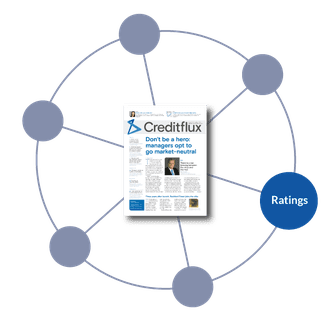

February 2021 | Issue 231
Analysis
CLOs
At least 2020 wasn’t dreadful for CLOs

Charlie Dinning
Data journalist

Tanvi Gupta
Head of data journalism
Last year’s downturn was another in which CLOs survived and in many cases thrived as
active management and Libor floors helped managers deliver 13%-plus returns to equity
In a year like no other, the CLO market proved its worth. Despite having to battle through a deluge of loan downgrades, a plethora of overcollateralisation (OC) test failures and the uncertainty around the US presidential election, US and European new issue CLOs that went effective in 2018 and 2019 averaged equity payments of 13.71% and 13.22% annualised, respectively.
However, there was a high level of dispersion among CLO managers in 2020. Eight US managers averaged payments under 10% annualised across 2020 on their eligible CLOs, while in Europe two managers (Anchorage Capital and Apollo Global Management (Redding Ridge)) fit this profile because they opted to defer payments.
Deferring — which is geared towards increasing the principal value of a CLO portfolio rather than distributions — had mixed results in Europe for PGIM, Barings and ICG, as well as Anchorage and Apollo. But the strategy proved effective for some US managers in Q4, with Angelo Gordon, Apollo and Fortress Investment Group landing fourth, fifth and sixth, respectively, in our ranking of Q4 average annualised payments.
2018/19 US CLOs: quarterly annualised payments to equity vs change in par*

*annualised payments over Q4 and change in par over Q3 **reset in Q4
US and European CLO markets finished 2020 with strong returns in the fourth quarter. The average annualised payment in the last three months of the year was above 16%. This came after a tough third quarter when a mismatch in Libor, issuers switching payment frequencies and interest smoothing in portfolios meant that US and European CLOs averaged distributions less than 10% annualised.
Many of the conditions which afflicted the market in Q3 moved in favour of CLOs in the following quarter. However, loan issuers switching to semi-annual payments mid-way through last year meant CLO coffers ran low in Q3 but were inflated in Q4. Some of the semi-annual payment issuers have now returned to quarterly payments, which means that future equity payments should be more consistent, sources say.


*deferred one or more payments in 2020 **reset in Q4
2018/19 Euro CLOs: quarterly annualised payments to equity vs change in par*
*annualised payments over Q4 and change in par over Q3
Volatility equals opportunity
The volatility in the CLO market early in 2020 presented managers with opportunities as new issue loan spreads widened and good credits were available at deep discounts.
London-based Guy Beeston, head of debt fund management at Commerzbank, was among those to capitalise. “We rotated the portfolio into new primary in 2020 that was coming out at good prices. When the crisis had just started, you had good primary emerging in May that was paying over 400-450bp for strong double B and single B assets and we took advantage of that and recycled a lot of the portfolio during the year. It was a year of active management and we’ve probably never worked as hard and as many hours in a year where we didn’t price a deal.”

“We remained disciplined”
Lee Kruter, Head of corporate bonds and loans | GoldenTree
The hard work looks to have paid off for the boutique CLO manager. Its only eligible CLO, Bosphorus IV, paid 23.59% annualised on its Q4 payment date, meaning Commerzbank topped the Q4 table for European CLO managers and posted a 2020 annualised figure of 14.53%, which was good enough for eighth in Europe.
Across the pond, US CLO equity payments in the last quarter of 2020 continued to benefit from Libor floors, with one manager estimating they added four points of annualised return. The floors meant that even lower spread loans, in the high-100s for example, could yield upwards of 3% if bought at a discount.
“It was a year of active management”
Guy Beeston, Head of debt fund management | Commerzbank
On top of this, CLO equity investors pointed to inflation of net asset values (NAV) in Q4 as a big reason for the return to form. The loan market rally, revival of OC ratios and the reduction in triple C holdings each played their part in boosting CLO equity NAVs. The loan rally was especially important, according to sources, who add that, as loan prices went up, some CLO equity NAVs went from 20 to 50 points.
These factors led to higher returns across the board, but once again it was GoldenTree Loan Management that achieved the highest averaged annualised payments to equity in the US and European CLO markets across 2020. The global CLO giant averaged 21.16% annualised across its four eligible US CLOs and 18.15% on its three European CLOs in 2020.
*deferred one or more payments in 2020 **reset in Q4
GoldenTree was never outside the top 10 in averaged annualised payments in any quarter in either market. It finished top in the US in Q2 and only Elmwood resetting its inaugural CLO in October denied GoldenTree the lead in Q4. GoldenTree also bested the rest of the European CLO market in quarters two and three.
Lee Kruter, partner and head of corporate bonds and loans at GoldenTree pointed out that strategy and portfolio positioning heading into 2020 was just as important as strategy during the volatility.
“While others were adding risk in late 2019/early 2020 when loan spreads were tight, we remained disciplined in our investment process and focused on margin of safety. Given the equity capital we have raised for our unique warehouse arrangements, we were able to ramp patiently during January and February when loan spreads were tight, then aggressively add in March and April as spreads widened significantly.”
“We were shocked by the par erosion”
Neil Desai, Head of structured credit investments | WhiteStar
Wiping away old tiers
Many CLO equity investors agree that 2020 was an important case study for manager trading behaviour, as it saw many CLO issuers move between tiers. Dallas-based Neil Desai, head of structured credit investments at WhiteStar Asset Management, says the shift in tiering was due to panic selling in March and April, and OC test management.
In some cases, he adds, his firm was “shocked by the amount of par erosion due to selling at the lows” and this changed its view on certain managers.
But he highlights the importance of understanding manager style as a part of the investment process. “On the flipside, you have some managers which let triple C baskets increase and allowed elevated warfs and even let deals trip OCs because they are committed on their process. Some of these deals don’t look pretty but you’re happy they stuck to their convictions,” he says.
Methodology
- Data includes CLOs that went effective in 2018 and 2019.
- Bond-flex, middle market and static CLOs were excluded.
- Annualised return (%) is calculated assuming equity issued at par.
- Manager change in WAS: average change in WAS over three months from first reports published after 30 June.
- Manager change in OC: average change in junior-most OC test results over three months from first reports published after 30 June.
- All data from CLO-i and Moody’s Analytics.
Share this article:

Global credit funds & CLO's
February 2021
| Issue 231Published in London & New York.
Copyright Creditflux. All rights reserved. Check our Privacy Policy and our Terms of Use.
























